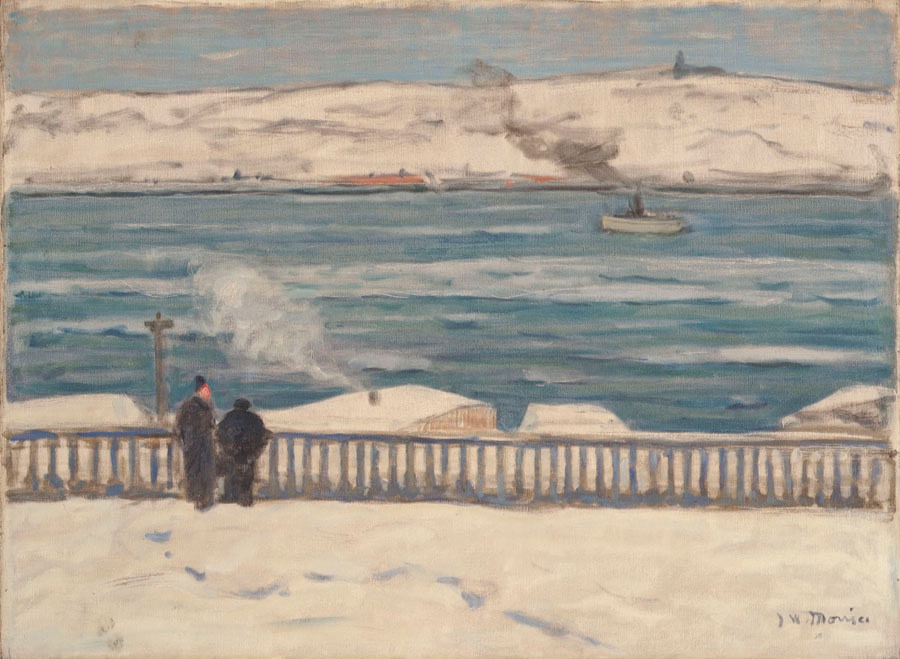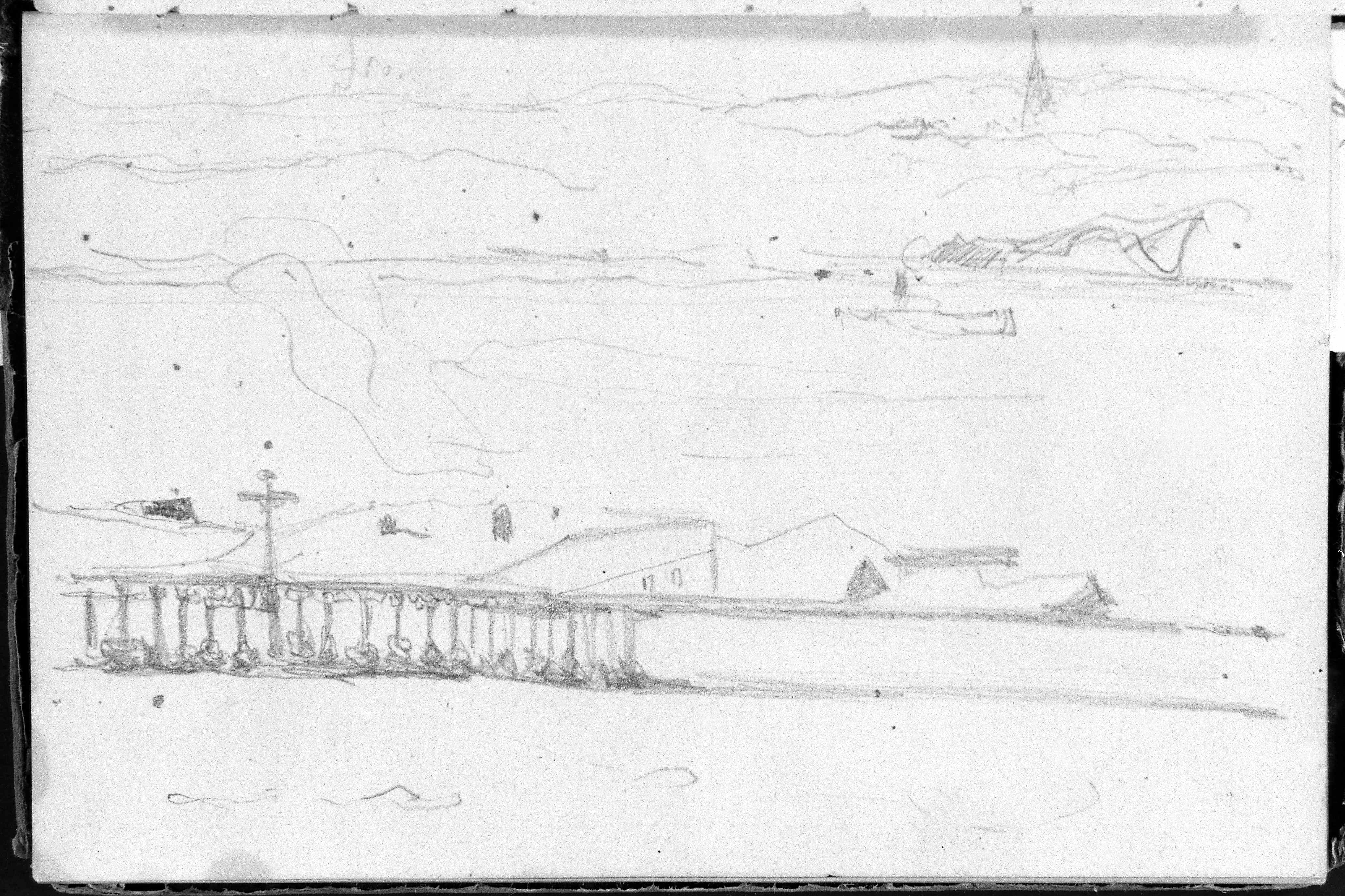Celebrated Morrice Canvas Never Before Sold

James Wilson Morrice, View Towards Levis from Quebec, 1909.
Oil on canvas 23 3/4 x 31 1/2 in (60.3 x 80 cm). Sold.
To see a Morrice canvas of Canadian subject matter on the market is a rare occurrence; when you add the fact that it was exhibited at the Paris Salon de la Société Nationale, it becomes an event. The artist’s Québec works account for less than seven percent of his total output, of which only 13 canvases (all winter scenes) were exhibited at that Salon, mostly between 1906 and 1909. The last canvas from that select group to appear on the Canadian market was Effet de neige (Québec), acquired by Ken Thomson at the November 2003 sale at Sotheby’s in Toronto (now Thomson Collection at the Art Gallery of Ontario). View towards Lévis from Québec was first shown at the 1909 Salon de la Société Nationale, together with Village canadien and four non-Canadian subjects, including two Etudes.
Thanks to John Lyman, we can identify View towards Lévis from Québec with catalogue no. 879, Québec: "One is a picture of a Canadian village in winter... another looking across from Quebec to Levis in winter, in wonderful blues..." (John Lyman, Letter to his father, May 1909). Lyman had discovered Morrice’s work two years earlier at the same Salon, when a friend showed him Le Bac (The Ferry, Québec, National Gallery of Canada). Both paintings represent the Saint Lawrence in winter seen from above, but from an inverted point of view: The Ferry is a view towards Québec City from the Lévis ferry quay, while the present canvas is a view of Lévis from the Château Frontenac, with the Dufferin Terrace at our feet.
James Wilson Morrice | View Towards Levis from Quebec, 1909 | oil on wood 5.1 x 6.7 ins. | National Gallery of Canada (no. 3192)
Purchased 1925 At the time of the Salon, in the Spring of 1909, Lyman was very impressed by the work of Henri Matisse, so much so that he will enter the Académie Matisse at Issy-les-Moulineaux the next September. A more mature artist, Morrice had also been interested in Matisse and the Fauves since the 1905 Salon d’Automne. Lyman probably saw that his new friend was also falling, although more discreetly, under the spell of Matisse. The composition of the View towards Lévis from Québec is more “thought out” than that of the 1907 Ferry, the alternating white and blue horizontals creating a surface pattern that is more decorative.
When we compare View towards Lévis from Québec with a recent photo (taken one floor above), we see that this “straightening” of the landscape was a deliberate, artistic choice. In reality, the opposite shore ends in the Pointe Lévis at left, and we clearly see the Ile d’Orléans behind it. View towards Lévis from Québec is based on a drawing (Sketchbook #15, page 26; Montreal Museum of Fine Arts, Dr.1973.38) and a small oil sketch (National Gallery of Canada, 3192), both jotted down from the Château Frontenac.
J.W. Morrice | View Towards Levis from Quebec, 1909 | Drawing Sketchbook 15, page 26 | Montreal Museum of Fine Arts, Dr. 1973.28
The sketch is already based on horizontal bands, but the local mix of earth and snow on the Lévis side has been preserved. In the drawing, the artist focused on the railing and its lamp post, and the wide gable of the Entrepôt Thibaudeau in lower town. But again, the view of the south side of the river, although very sketchy, is already seen as a horizontal band. On the other hand, the spire of Saint-Joseph de Lévis, which in reality is further to the west, and much smaller, was planted with aplomb in the drawing, and will alone signal the upper part of Lévis in the final painting. Morrice lightens this slightly rigid composition with humour: his trademark plump figure, here a man seen from the back, is a metaphor for the artist (and spectator) observing the panorama. But, unlike his taller and leaner companion, he has not left his footprints in the snow... How long has he been standing there? The abundant smoke and the dark shade of the water confirm that the weather was “Fine and very cold” (The Gazette, Montreal, Feb. 1, 1909). But don't take pity on the poor artist. He was comfortably ensconced in a lounge or the dining room of the hotel. The exact location was revealed in a photo I took from the second floor, on the side that overlooks the Champlain Monument and the Funicular entrance. It was always known that the View Towards Lévis was painted from Dufferin Terrace, but probably outdoors near the River façade, like this other photo of mine (Dec. 2011). William R.M. Johnston, however, did suggest “Morrice’s hotel window” as the probable location (Morrice exhibition, MMFA 1965, Cat. 15), but the point of view of the painting is much too low.
 View over Dufferin Terrace, the St. Lawrence River towards Point Levis from the Bar St. Laurent at the Chateau Frontenac, Quebec City
View over Dufferin Terrace, the St. Lawrence River towards Point Levis from the Bar St. Laurent at the Chateau Frontenac, Quebec City
If we know the temperature that Morrice experienced during his trip it’s because we can actually pinpoint the exact time when Morrice visited Québec. He had arrived in Montreal, via New York, just in time to celebrate Christmas of 1908 with his family; he planned to stay a few months and try to make some sales. But his crate of paintings, sent separately, was slow to arrive, so near the end of January he left for a few days to Quebec City and the Montmorency Falls (undated letter to Edmund Morris in Toronto, AGO Library). He was still in Montreal on the 26th, when he was spotted previewing an exhibition of the French art at the Art Association (La Presse, Jan. 27). He was already back at his parents house a week later with “some good sketches”, adding that he was “working like a slave on show pictures” (letter to Morris, Feb. 3, AGO Library). The two Paris Salon pictures, Québec (now known as the our View towards Lévis from Québec) and its companion, Village canadien (now Entrance to a Québec Village) were probably painted after Morrice’s return to Paris at the end of February, 1909.
As his six entries had to be in by March 30th, he quickly selected four older European subjects, and gave all his attention to new winter scenes. Both have the same dimensions, and share a palette dominated by white, blue and pink. Village canadien, probably a view near Montmorency Falls, is mostly white with important pink accents, while View towards Lévis from Québec is mostly white and blue. By that time, Morrice's compositions had evolved to a few horizontal bands, painted with aneconomy of material; he still used a variety of colours and tones applied in light passages, always submitted to the total harmony. Note how, in the View towards Lévis from Québec, he rendered the normally white ferry in muted green, to better blend in and not break the white-blue-white-(blue) pattern. That schematization of the composition prefigures the direction that Morrice's painting will take in the future. He had met Matisse in the Fall of 1908, both men being on the Painting jury of the Salon d'Automne; they will meet again in Tangiers in early 1912. In the Salon d’Automne that year, Morrice will show Tanger [The Beach] (The Thomson Collection, AGO) which, with its three-tier composition dominated by a central blue band, is very reminiscent of his View Towards Lévis from Québec.
Copyright © Lucie Dorais, May 2013
Ms. Dorais did her M.A. Thesis on the early life and career of James Wilson Morrice (Université de Montréal, 1980). She had a promising career at the National Archives of Canada. Now retired, she is considered by academics, collectors and art merchants to be a foremost scholar on James Wilson Morrice. Ms. Dorais continues to compile information on the artist, including the Catalogue Raisonné of his oeuvre.
Comments
thankyou
frances Palmer
Have recently come to put some active interest in looking at some
art. Have a beautiful Robert Cauchon ,
watercolor,,any suggestions?
With thanks.
Stella







